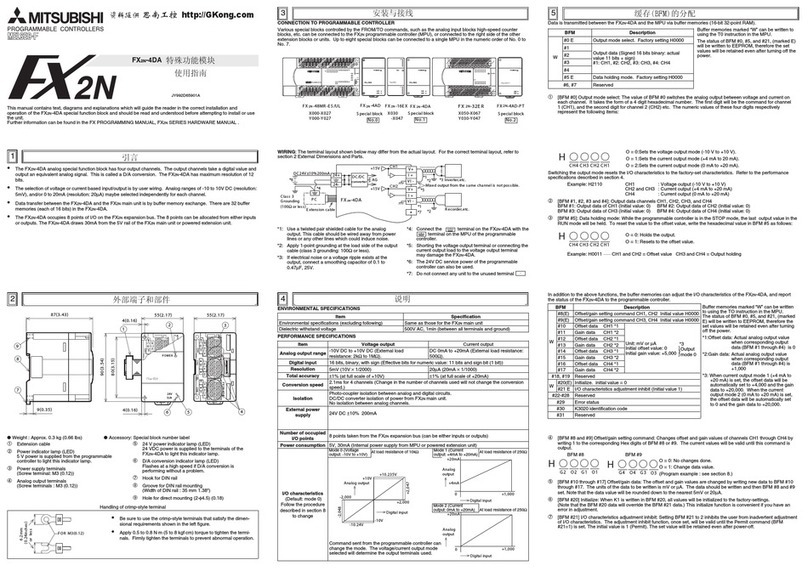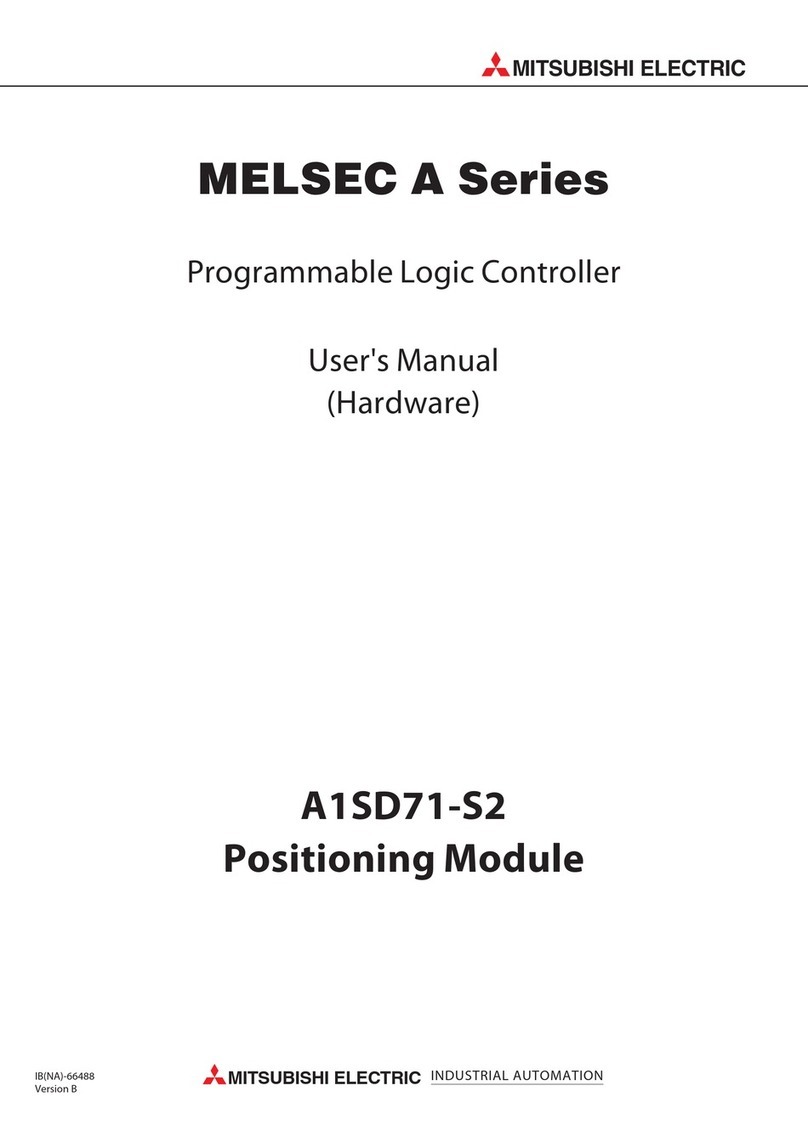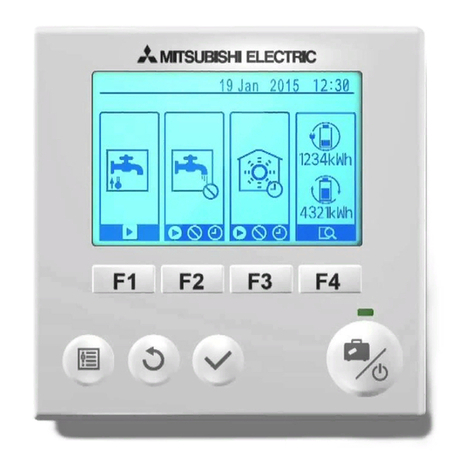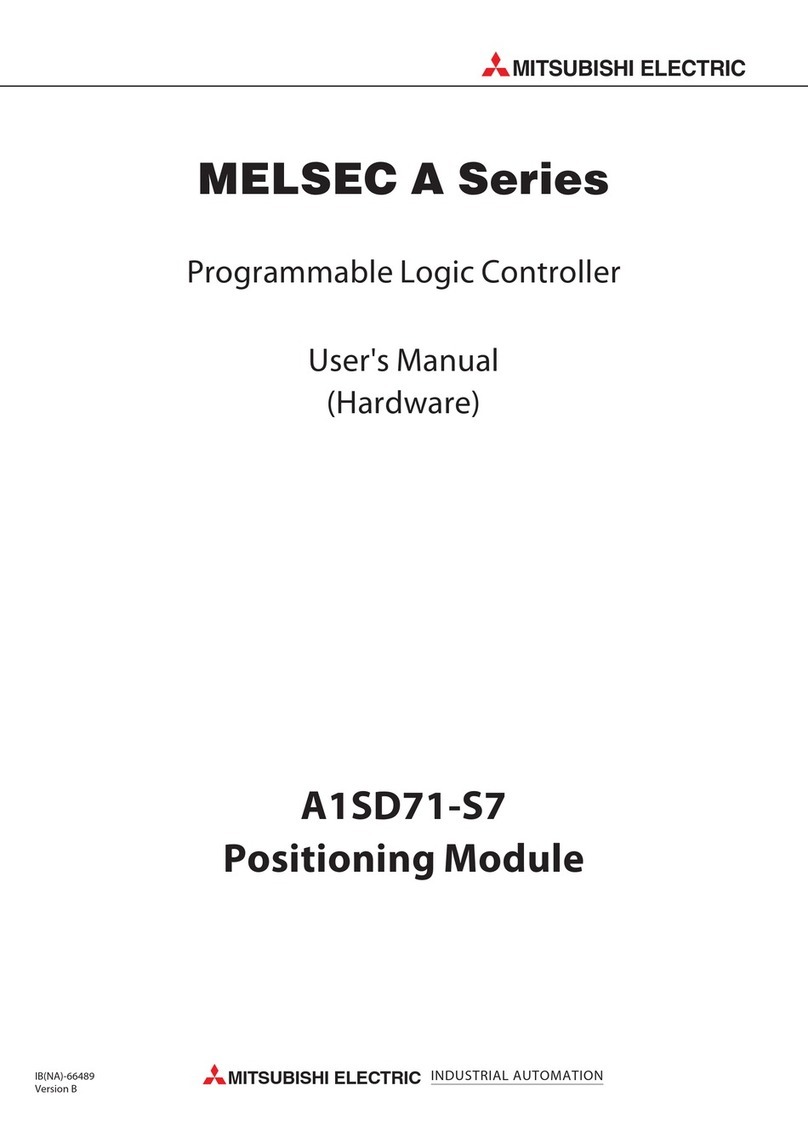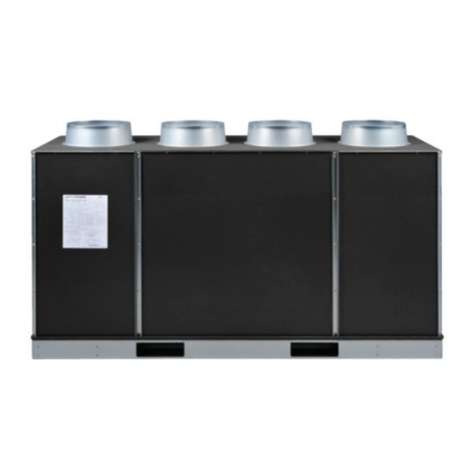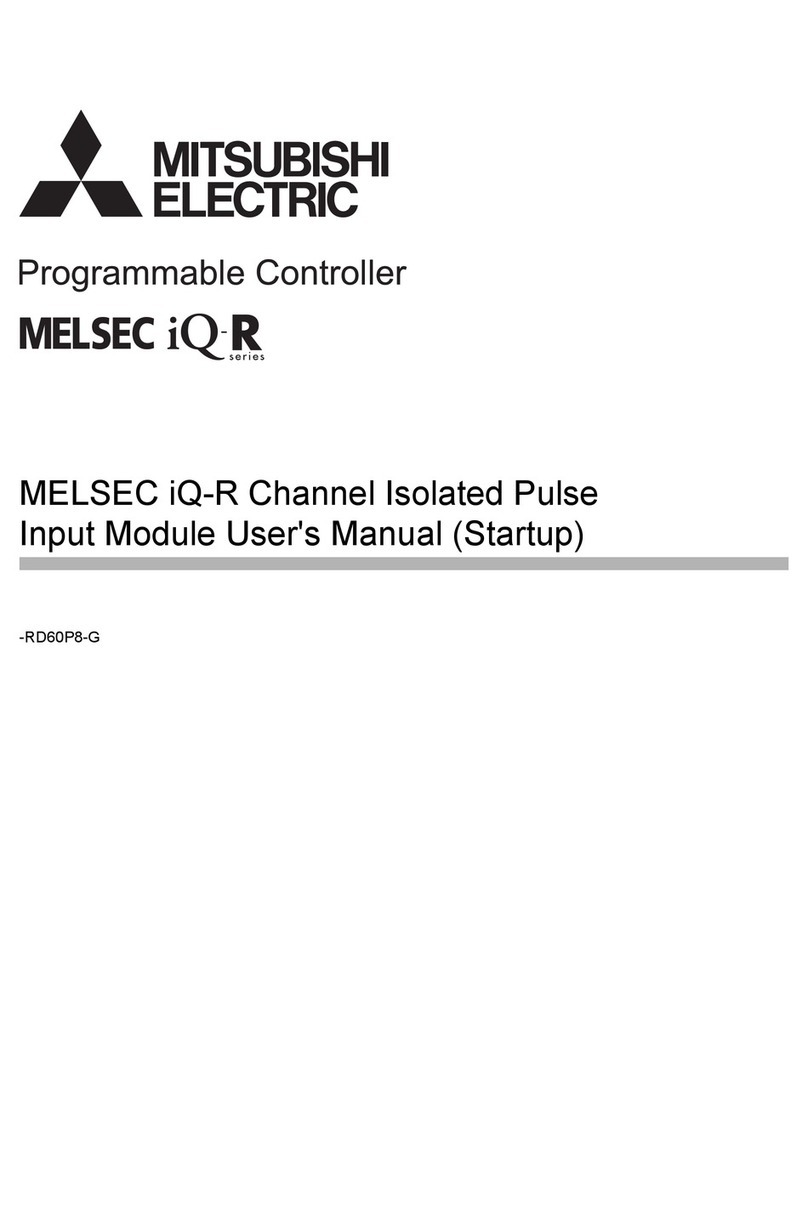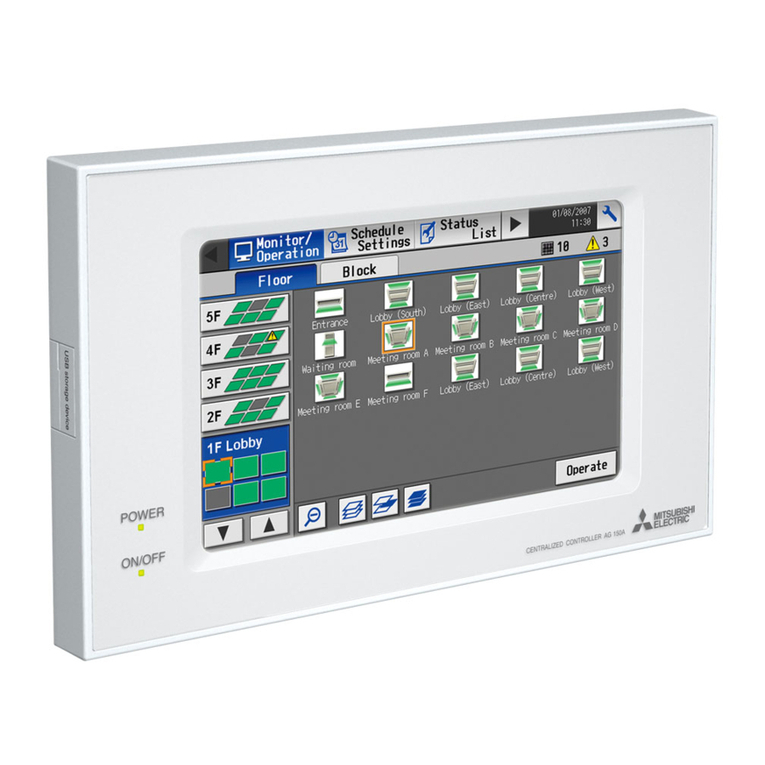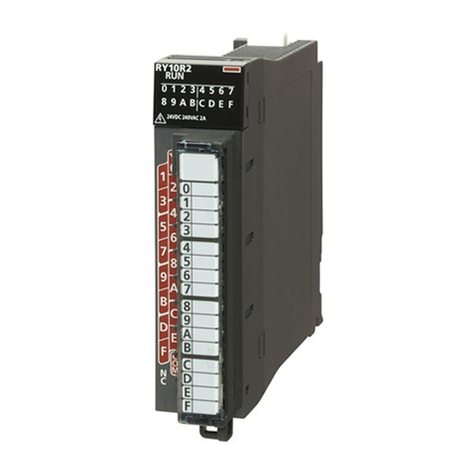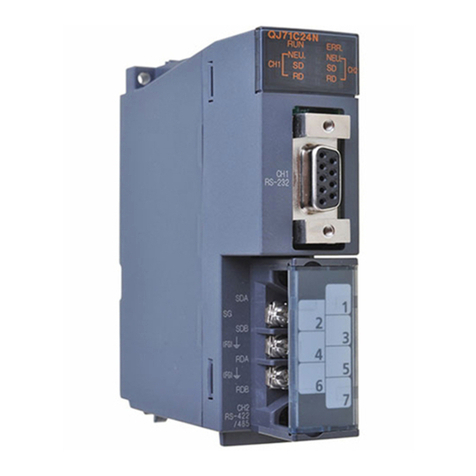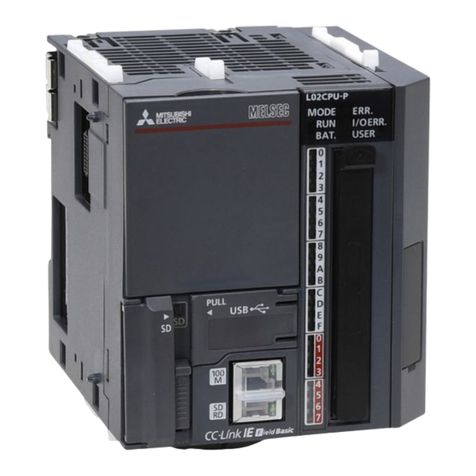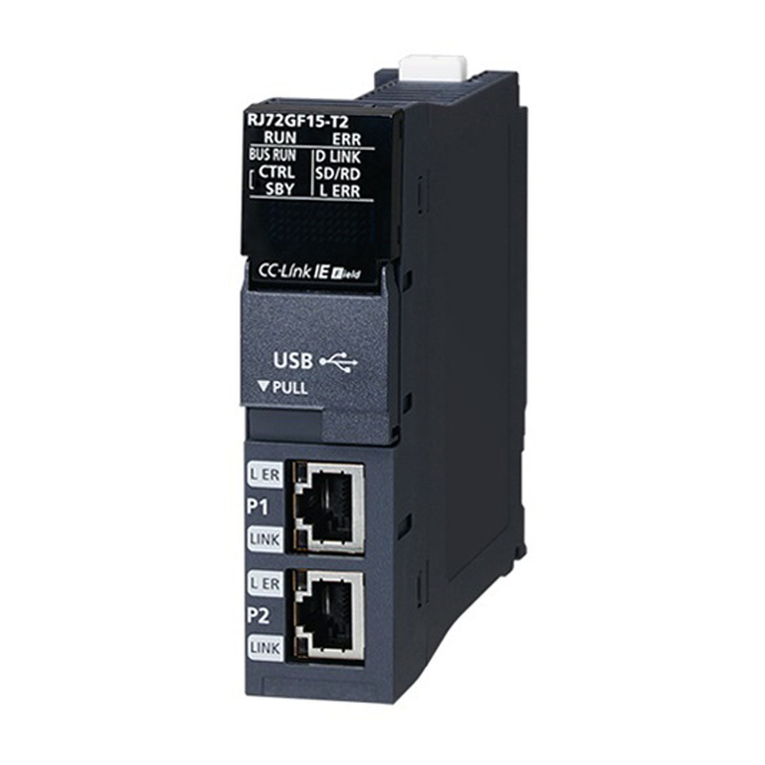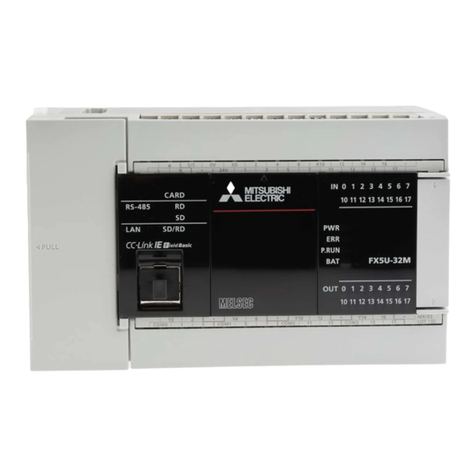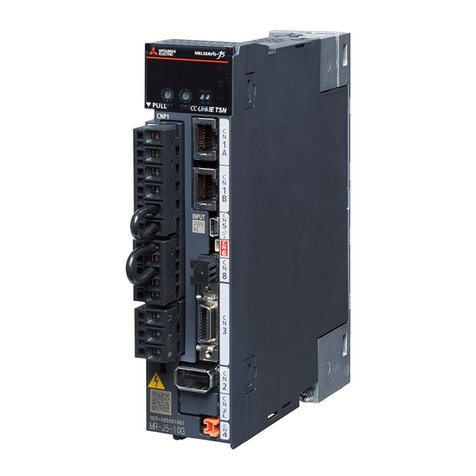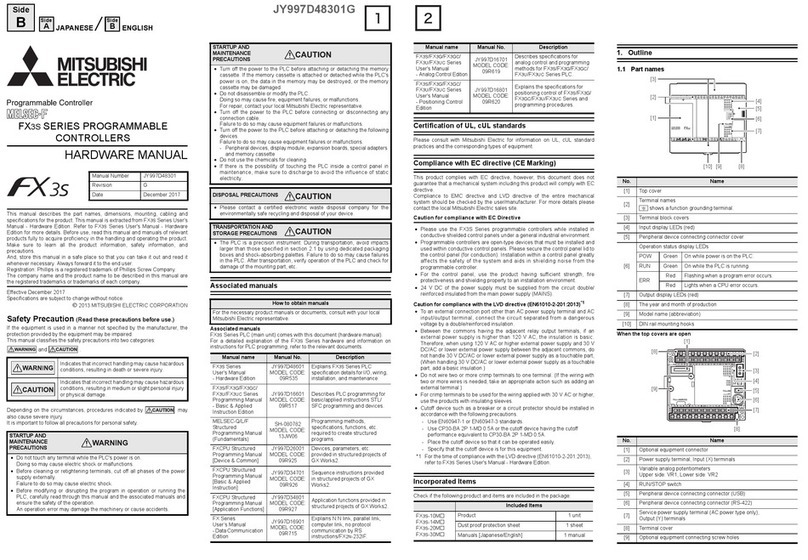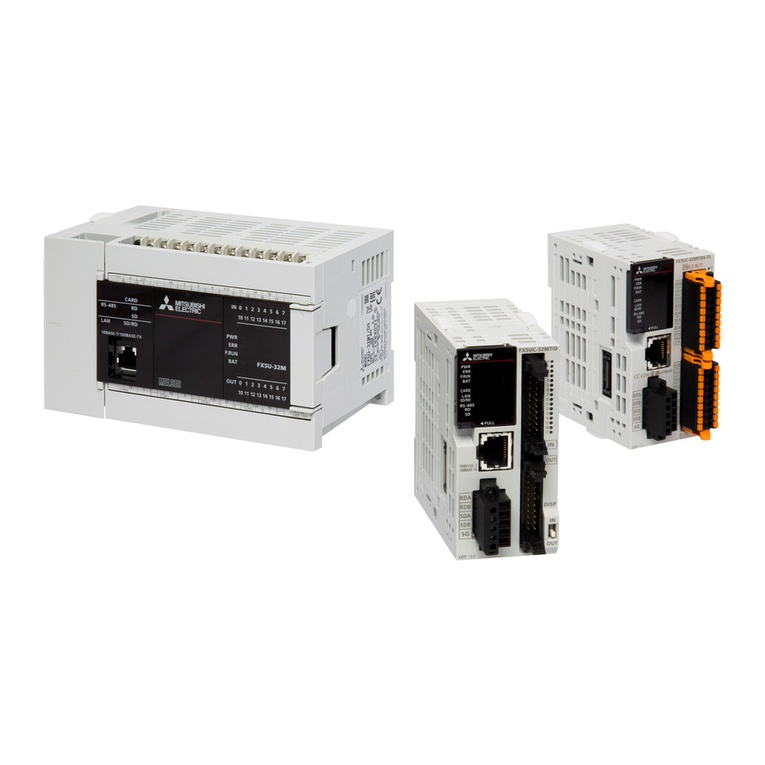
This manual contains text, diagrams and explanations which will guide the reader in the correct installation and
operation of the FX2N-232-BD and should be read and understood before attempting to install or use the unit.
Further information can be found in the FX SERIES PROGRAMMING MANUAL, FX2N SERIES HARDWARE MANUAL
and FX-485PC-IF USER’S MANUAL.
The communication board FX2N-232-BD for RS232C (hereinafter referred to as “232BD”) can be connected to the main
unit of the FX2N Series programmable controller, and used as the port for the following applications.
(1) To perform data transfer between RS232C devices such as personal computers, bar code readers and printers.
(2) To perform data transfer using the dedicated protocol between RS232C devices. For details of the dedicated
protocol, refer to the users manual of the FX-485PC-IF.
(3) To connect a programming tool.
And when the 232BD is used for the application (1) or (2) above, the communication format including the baud rate, the
parity and the data length is specified by the parameters or the contents of the special data register D8120 of the FX2N
programmable controller.
Only one 232BD can be connected to one base unit. Accordingly, the 232BD cannot be used together with the
FX2N-485-BD or the FX2N-422-BD. When two or more RS232C units are required to be connected for the application,
use the special block for RS232C communication.
1.1 EXTERNAL DIMENSIONS
Dimensions : mm (inches) Accessory : M3 self-tapping screws ×2, mounting bracket ×2
➀Mounting holes <2-φ4.0 (0.16")>
➁Connector for programmable controller
➂RXD LED : Flashes at high speed during sending.
➃TXD LED : Flashes at high speed during sending.
➄Connector (9-pin D-SUB type) for peripheral unit
The top face of this connector is higher than the top face of the panel
cover of the programmable controller by approximately 3 mm (0.12")
or by approximately 50 mm when the cable is connected.
➅Mounting holes of connector <2 - M2.7 (0.11") ×0.635 (0.025")>
The connector is a 9-pin D-SUB type, and the pin configuration is as shown below.
54(2.13")
46(1.81")
39
35
1
1
234
5
24.99(0.98")±0.3(0.012")
6
3.1 General specification
General specifications is same as those for the FX2N series programmable controller.
3.2 Power supply specification
5 V DC, 60 mA is required from the programmable controller.
3.3 Specification
Transmission standard Conforming to RS232C
Transmission distance Max. 15m
Connector 9-pin D-SUB type
Pin layout of connector 1:CD(DCD) 2:RD(RXD) 3:SD(TXD) 4:ER(DTR) 5:SG(GND) 6:DR(DSR)
7,8,9:NC(No connection)
LED indicators RXD, TXD
Communication method Half-duplex communication system
Protocol Programming protocol, dedicated protocol (format 1 or 4), non protocol
Isolation No isolation
Pin No. Signal Meaning Function
1CD(DCD) Carrier detection ON when carrier is detected for data reception
2RD(RXD) Receive data Receive data (RS232C device to232BD)
3SD(TXD) Send data Send data (232BD to RS232C device)
4ER(DTR) Send request Signal requesting preparation for data sending to RS232C
device
5SG(GND) Signal ground Signal ground
6DR(DSR) Send enable Shows RS232C device is ready to receive
7,8,9 NC No connection
3.4 Related flag and data registers
3.5 Communication format D8120
To send and receive the data between the RS232C unit using the 232BD, the communication format including the
transmission speed (baud rate) and the parity must be consistent between the 232BD and the RS232C unit.
The communication format can be set using parameters or the contents of special data register D8120 of the FX2N
programmable controller. Make sure to set appropriately the communication format in accordance with the RS232C unit
used. For the setting method using the parameters of the FX2N programmable controller, refer to the manual of the
peripheral unit used.
Make sure to turn off the power of the programmable controller and turn it on again after modifying the setting.
Diagnostic
devices Operation
M8121 Data transmission delayed (RS instruction)
M8122 Data transmission flag (RS instruction)
M8123 Finished receiving data (RS instruction)
M8124 Carrier detection flag (RS instruction)
M8126 Global flag (dedicated protocol)
M8127 On demand handshake flag (dedicated protocol)
M8128 On demand error flag (dedicated protocol)
M8129 On demand Byte/Word flag (dedicated protocol)
M8161 Selection of 8 bit operations for applied instructions
ASC, RS, ASCI, HEX, CCD (RS instruction)
Diagnostic
devices Operation
D8120 Communications format (RS instruction, dedicated protocol)
D8121 Local station number (dedicated protocol)
D8122 Amount of data to be transmitted (RS instruction)
D8123 Amount of remaining data already received (RS instruction)
D8124 Data header <default STX (02H)> (RS instruction)
D8125 Data terminator <default ETX (03H)> (RS instruction)
D8127 On demand head device register (dedicated protocol)
D8128 On demand data length register (dedicated protocol)
D8129 Data network ‘time-out’ timer value (dedicated protocol)
*1 Set to “0" when using the dedicated protocol.
*2 Effective only when no protocol (RS instruction) is selected, and has an initial value of STX (02H: Can be modified by
the user).
*3 Effective only when no protocol (RS instruction) is selected, and has an initial value of ETX (03H: Can be modified by
the user).
*4 Set to (b11, b12) = (1, 0) when using the dedicated protocol.
*5 Set to “0" when using no protocol.
3.5.1 Example program of setting
The communication format is set by special data register D8120.
Setting the communication format using D8120 is effective only at the time the
RS instruction is driven, and therefore if changed after driving, it is not actually
accepted.
An example of setting D8120 is shown below.
H138F = 0001 0011 1000 1111(binary)
The settings for the above program are as right.
Bit
No. Meaning Contents
0 (OFF) 1 (ON)
b0 Data length 7 bit 8 bit
b1
b2 Parity b2,b1 b2,b1
(0, 0) : None (1, 1) : Even
(0, 1) : Odd
b3 Stop bit 1 bit 2 bit
b4
b5
b6
b7
Baud rate (bps)
b7,b6,b5,b4 b7,b6,b5,b4
(0, 0, 1, 1) : 300 (0, 1, 1, 1) : 4,800
(0, 1, 0, 0) : 600 (1, 0, 0, 0) : 9,600
(0, 1, 0, 1) : 1,200 (1, 0, 0, 1) : 19,200
(0, 1, 1, 0) : 2,400
Bit
No. Meaning Contents
0 (OFF) 1 (ON)
b8 Header character
*1 None D8124 *2
b9 Terminator
character *1 None D8125 *3
b10 Reserved
b11 DTR check
(Control line) *4 Send and receive Receive
b12 Control line *4 None H / W
b13 Sum check *5 Sum check code
is not added
Sum check code
is added
automatically
b14 Protocol No protocol Dedicated protocol
b15 Transmission
control protocol *5 Protocol format 1 Protocol format 4
The control line is set by b12.
b12 = 0 : No hardware hand shaking. Send and receive are controlled by software protocol.
b12 = 1 : Hardware hand shaking. Signal lines ER(DTR)and DR(DSR)are used to control send and receive of data.
Data length 8 bit
Parity Even
Stop bit 2 bit
Baud rate 9,600
Protocol No protocol
Header Used
Terminator Used
Control line H/W
DTR check Send and receive
To connect the 232BD to RS232C device use an RS232C cable. Make sure that the shield of cables is connected to
ground (100 Ωor less).
The connector of the 232BD is 9-pin D-SUB (see Section 1.2 and Chapter 2). The connections of RS232C devices
varies with each device being used. Check the specification of the device, and connect.
4.1 Connection examples
4.1.1 Terminal specification device
4.1.2 Modem specification device
4.1.3 When programming or monitoring
Use F2-232CAB-1 and 25-pin D-SUB to 9-pin D-SUB adapter or make a suitable cable.
Turn off the power of the programmable controller, and mount the 232BD using the following procedure.
➀Remove the panel cover from the top face of the main unit.
➁Connect the 232BD to the board mounting connector provided on the base unit.
➂Fix the 232BD to the main unit using the M3 self-tapping screws provided,
fitting the mounting bracket and the round crimp-style terminal with the
ground cable as shown in the figure on the right.
Make sure that the crimp-style terminal is attached in the direction shown
in the figure on the right, and that the ground cable extends from the unit
shown in the figure below.
Tightening torque: 0.3 to 0.6 Nm (3 to 6 kgf⋅cm)
➃Cut out the hole provided on the left portion of the panel cover using a tool
such as nippers and cutter so that the terminal block can be seen. The top
face of this connector is higher than the top face of the panel cover of the
programmable controller by approximately 7 mm (0.27").
232BD
9-pin D-SUB
2 RD (RXD)
3 SD (TXD)
4 ER (DTR)
5 SG (GND)
6 DR (DSR)
RS232C device
3
5
4
3
2 2
7
6
20
2
3
74
32
6 85
57
Meaning 25-pin
D-SUB
Meaning 9-pin
D-SUB
25-pin
D-SUB 9-pin
D-SUB
Uses RS, CSUses ER, DR *
RD (RXD)
CS (CTS)
RS (RTS)
RD (RXD)
DR (DSR)
SG (GND)
ER (DTR)
SD (TXD) SD (TXD)
SG (GND)
When using ER and DR signals, please also check if RS and CS signals are needed according to the
RS232C device's specifications.
*
232BD
9-pin D-SUB
2 RD (RXD)
3 SD (TXD)
4 ER (DTR)
5 SG (GND)
6 DR (DSR)
1 CD (DCD)
RS232C device
3
5
4
3
2 2
7
6
20
2
3
74
32
6 85
57
Meaning 25-pin
D-SUB
Meaning 9-pin
D-SUB
25-pin
D-SUB 9-pin
D-SUB
Uses RS, CSUses ER, DR *
RD (RXD)
CS (CTS)
RS (RTS)
RD (RXD)
DR (DSR)
SG (GND)
ER (DTR)
SD (TXD) SD (TXD)
SG (GND)
When using ER and DR signals, please also check if RS and CS signals are needed according to the
RS232C device's specifications.
CD (DCD) CD (DCD)
18 18
*
X1 X3
Y1
Y0 Y2
232BD
13
4
2
For M3(0.14")
16mm(0.63") or less
5.5mm(0.22") or less
FX2N-232-BD COMMUNICATION BOARD
USER’S GUIDE
JY992D66001A
b12 1
b11 0 Data Data
Send
When sending
3 SD (TXD)
4 ER (DTR)
6 DR (DSR)
Pin No.
Data Data
Receive
When receiving
2 RD (RXD)
4 ER (DTR)
6 DR (DSR)
Pin No.
b12 1
b11 1 Data
Send
3 SD (TXD)
2 RD (RXD)
4 ER (DTR)
Pin No.
6 DR (DSR)
Data
Receive
MOV H138F D8120
M8002
1
2
3
4
5
6
7
8
9
Grounding
Cable
INTRODUCTION
1
TERMINAL LAYOUTS
2
SPECIFICATION
3
WIRING
4
MOUNTING PROCEDURE
5
